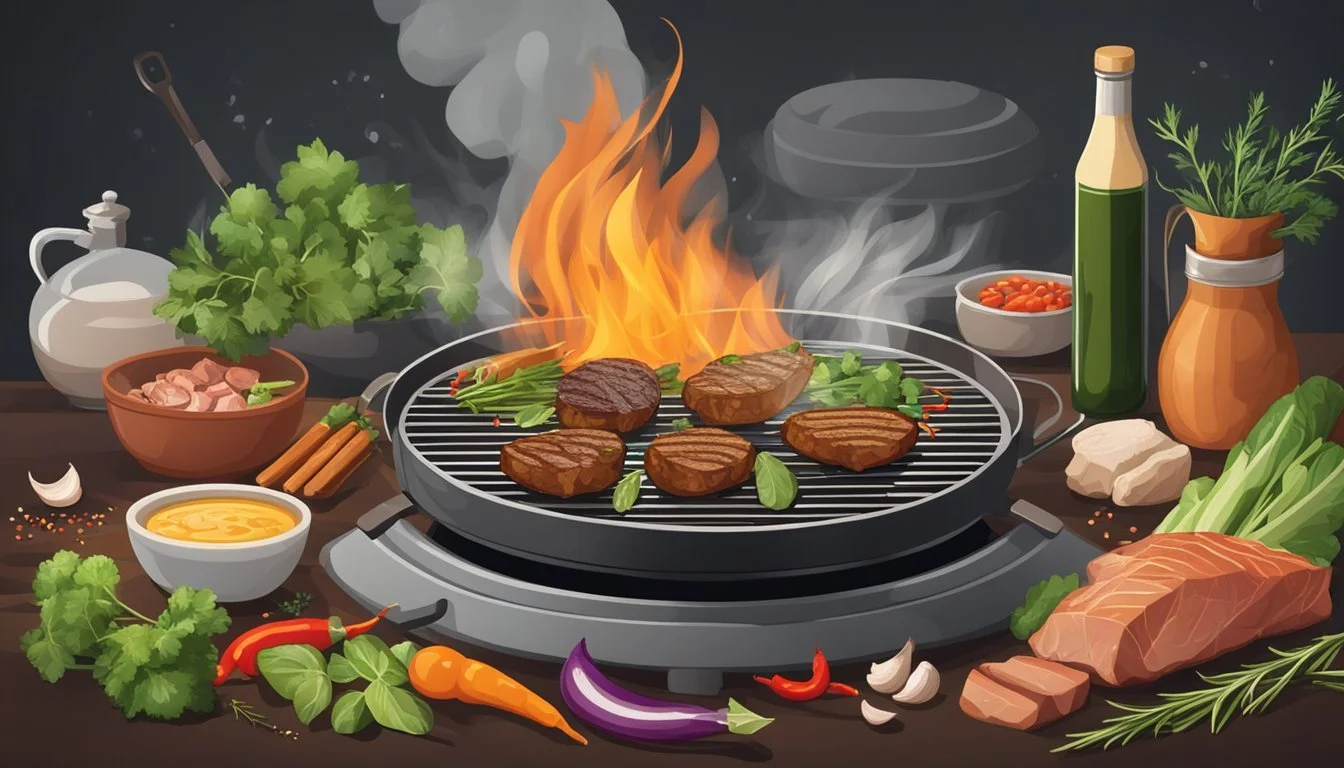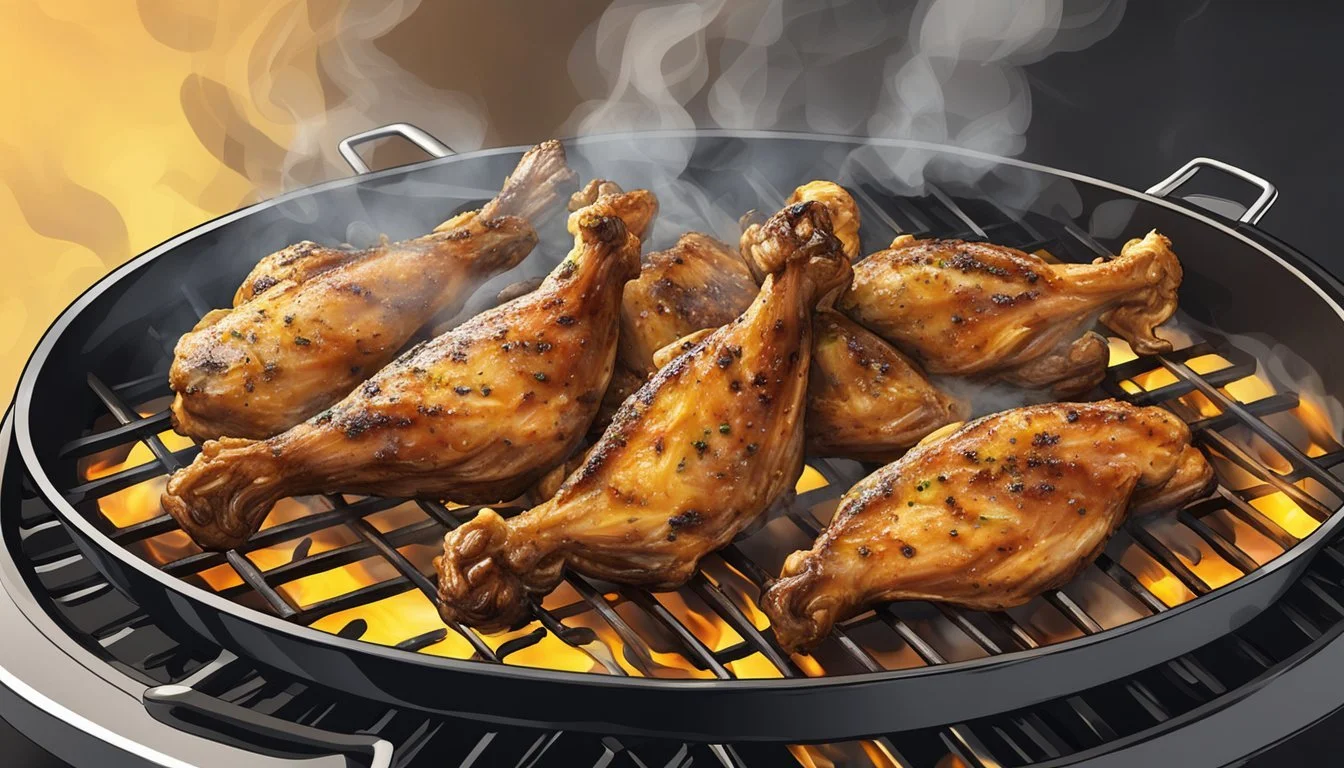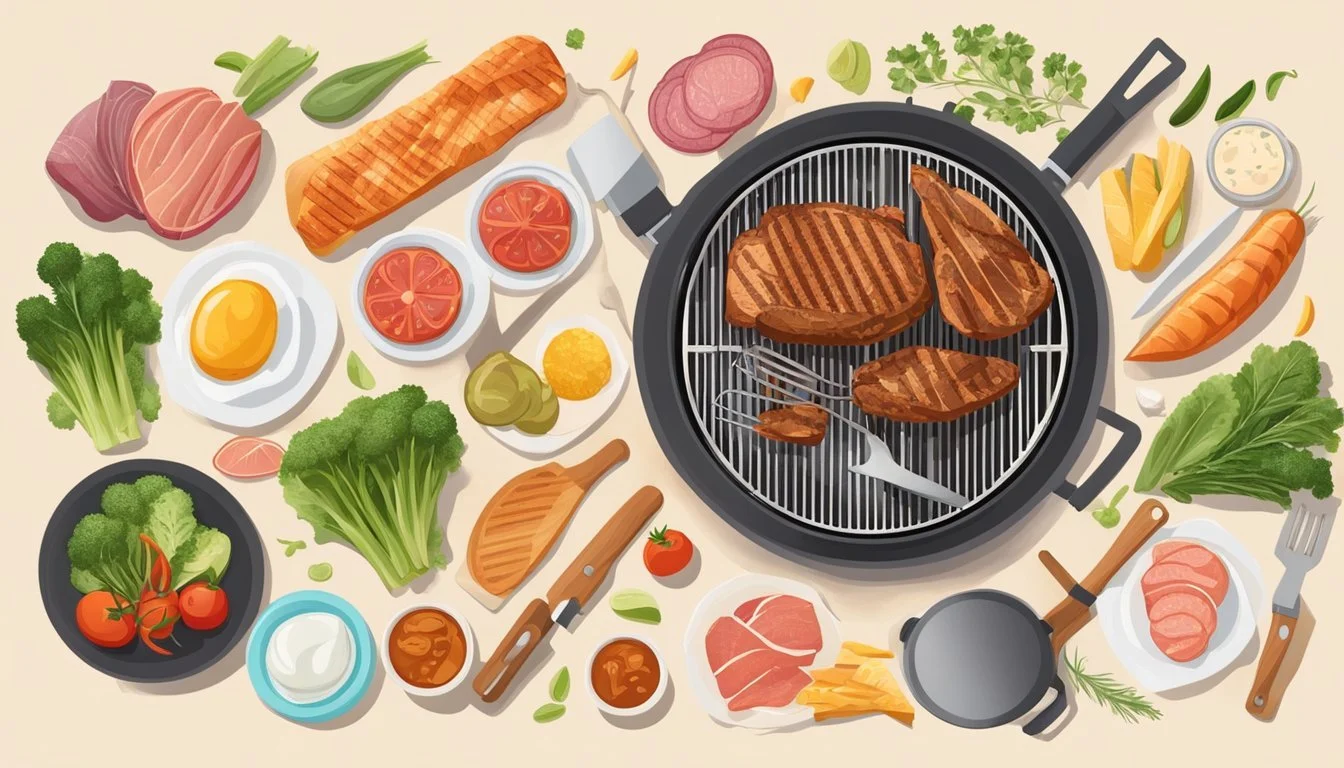5 Carnivore Diet-Friendly Grilling Recipes for Perfect BBQ
Grilling is an essential technique for anyone on the carnivore diet, offering a delicious way to prepare a variety of meats while retaining their natural flavors and nutrients. Whether it's beef, poultry, or fish, grilling brings out the best in these protein-rich foods, making it easier to stick to a meat-focused eating plan.
These recipes not only adhere to the principles of the carnivore diet but also provide satisfying and savory meals suitable for any occasion. From juicy steaks to tender ribs, these grilling recipes will appeal to both seasoned carnivores and those new to the diet, ensuring meals are both tasty and nutritionally beneficial.
1) Grilled Ribeye Steak
Grilled ribeye steak is a favorite for those on a carnivore diet. It's simple, delicious, and full of flavor. Start by preheating the grill to medium-high heat.
Season the ribeye steak generously with salt and pepper on both sides. Let it sit at room temperature for about 15-20 minutes. This helps the steak cook evenly.
Place the steak on the grill. Cook for 4-5 minutes on each side for medium-rare. Adjust grilling time based on your preferred doneness. Use a meat thermometer to ensure accuracy.
Consider adding a bit of flair by grilling bone marrow alongside the steak. Simply place bone marrow slices on a grill-safe tray or directly onto the grill.
Combine the grilled steak with buttered bone marrow for a rich and satisfying dish. Tent the steak with foil and let it rest for 7-10 minutes before slicing.
Slice the steak against the grain to keep it tender. Serve with a sprinkle of freshly minced parsley, pepper, and flakey salt to enhance the flavors. Enjoy this hearty and protein-packed meal straight from the grill.
2) Lemon Herb Grilled Chicken Wings
Lemon herb grilled chicken wings are a flavorful and easy-to-prepare option for those on a carnivore diet. Start by marinating the wings. Combine olive oil, lemon juice, and a mix of spices like salt, pepper, and herbs.
Make sure the wings are well-coated and let them marinate for at least 30 minutes. For deeper flavor, refrigerate overnight.
Preheat an outdoor grill for about 5 minutes. Ensure it's properly heated to get even cooking.
When ready, place the marinated wings on the grill. Cook them on medium heat, turning occasionally, until they reach an internal temperature of 165°F (74°C).
This usually takes about 20-25 minutes. The lemon juice and herbs provide a zesty, fresh flavor that pairs perfectly with the charred, smoky taste from the grill.
These wings are not only delicious but also fit perfectly into a carnivore diet lifestyle, making them a great addition to any barbecue.
3) Garlic Butter Grilled Lobster Tails
Garlic butter grilled lobster tails make for a delightful and indulgent addition to any carnivore diet. The rich flavors of garlic and butter enhance the natural sweetness of the lobster meat.
Begin by preparing a garlic butter mixture. Combine melted butter, minced garlic, lemon juice, and your choice of herbs such as chives or parsley in a small bowl. Season with salt and pepper.
Next, prepare the lobster tails. Using kitchen shears, cut down the middle of each lobster shell, stopping at the tail. Carefully cut the meat, ensuring not to slice all the way through.
Preheat the grill to medium-high heat. Lightly oil the grill grates to prevent sticking. Place the lobster tails flesh side down on the grill for about 5-6 minutes, until lightly charred.
Flip the lobster tails over and brush generously with the garlic butter mixture. Close the grill lid and cook for an additional 4-6 minutes until the flesh is opaque and the internal temperature reaches 145 degrees F.
Remove from the grill and serve hot with a squeeze of fresh lemon. These garlic butter grilled lobster tails provide a succulent and flavorful option suitable for those adhering to a carnivore diet.
Spicy Grilled Lamb Chops
Spicy grilled lamb chops are a delight for anyone on a carnivore diet. They offer a rich, savory experience with a hint of heat, making them a go-to option for grilling enthusiasts.
Begin by preparing a spice mix. Combine chili powder, paprika, garlic powder, salt, and pepper in a small bowl. This mixture will serve as a robust rub for the lamb chops.
Pat the lamb chops dry and generously coat them with the spice mix. Ensure that the seasoning covers all sides.
For best results, let the seasoned lamb chops rest in the refrigerator for a couple of hours. This allows the flavors to fully penetrate the meat, creating a more intense taste.
Preheat the grill to medium-high heat. Once hot, place the lamb chops directly on the grill grates. Close the lid and cook for about 3-4 minutes per side to achieve a medium-rare finish.
If you prefer a spicier kick, brush each side with a spicy BBQ sauce during the last minute of grilling. This adds an extra layer of heat and flavor.
Remove the lamb chops from the grill and let them rest for a few minutes. This helps the juices redistribute, ensuring a tender and juicy bite. Serve immediately and enjoy.
5) Cedar Plank Grilled Salmon
Cedar plank grilled salmon is a delicious and aromatic option for those following a carnivore diet. This cooking method uses a soaked cedar plank to infuse the fish with a subtle smokiness and keeps it moist while grilling.
To start, soak the cedar plank in water for at least two hours. This prevents the wood from burning and ensures a slow, even cook.
The salmon fillets are placed skin side down on the plank, seasoned with salt and pepper, and drizzled with sesame oil. Adding a couple of lemon slices on top provides a fresh, citrusy note that complements the fish.
Set up the grill for indirect cooking on medium heat. Place the cedar plank with the salmon over the cooler side of the grill. Close the lid to maintain an even temperature.
Grill the salmon for about 15-20 minutes, or until the flesh is opaque and flakes easily with a fork. An internal temperature of 140°F indicates it’s perfectly done.
Carefully remove the cedar plank from the grill using a spatula. Serve immediately, allowing the rich, smoky flavors to shine through. This simple yet flavorful recipe is sure to be a hit at any summer cookout.
Nutritional Benefits of Carnivore Diet-Friendly Grilling
Grilling on a carnivore diet offers many nutritional benefits, notably high protein content and essential fatty acids, key to maintaining muscle mass and supporting overall health.
High Protein Content
Grilling methods such as using direct heat or plank grilling can help retain the high protein content in various meats. Protein is vital for muscle repair, growth, and overall bodily functions. For instance, grilling beef or chicken helps keep the protein intact while enhancing flavor without the need for added carbohydrates. A 3-ounce grilled beef patty can contain approximately 22 grams of protein, making it an excellent choice for those looking to boost their protein intake while following a carnivore diet.
Maintaining protein levels is crucial, especially for people engaging in physical activities. The grilling process also allows the essential amino acids in the meat to remain more bioavailable, which aids in better absorption by the body. Ensuring a diet rich in high-quality protein can help with sustained energy levels and satiety.
Essential Fatty Acids
Grilled meats are an excellent source of essential fatty acids, such as omega-3 and omega-6, crucial for heart health, brain function, and reducing inflammation. For example, grilling salmon on a plank not only gives the meat a smoky flavor but also helps preserve its healthy fats. These fatty acids cannot be synthesized by the body and must be obtained through diet.
A 3.5-ounce serving of grilled salmon can provide around 1,200 milligrams of omega-3 fatty acids. Including such sources in a carnivore diet ensures that one receives adequate amounts of these essential fats. The process of grilling, particularly with indirect heat, helps to maintain the integrity of these fatty acids, making it a healthful cooking method for those adhering to a carnivore lifestyle.
Best Practices for Grilling Meat on a Carnivore Diet
Grilling on a carnivore diet requires attention to the type of meat, proper marination, and ideal cooking temperatures. These factors significantly impact the taste and texture of the grilled meat.
Choosing the Right Cuts
The cut of meat chosen can greatly affect the grilling experience and outcome. Ribeye, sirloin, and T-bone steaks are excellent choices due to their balance of fat and muscle. Fatty cuts provide flavor and tenderness, essential for a satisfying carnivore meal.
Lean cuts like flank steak can be used but may require more attention to avoid drying out. Bone-in cuts often impart flavor and help maintain moisture. It's essential to select high-quality, fresh meat for the best results.
Marinating Tips
Marination helps in tenderizing the meat and infusing flavors. While the carnivore diet typically avoids plant-based ingredients, using animal-based marinades can enhance the meat. Bone broth, tallow, and lard are excellent choices.
Salt and pepper should be generously applied, as they bring out the meat's natural flavors. Allowing the meat to marinate for a few hours or overnight helps in achieving optimal tenderness. Avoid sugary or acidic marinades, which are not suitable for the carnivore diet.
Optimal Grilling Temperatures
Grilling meat to the right temperature is crucial for both safety and flavor. Steaks are best cooked at medium-high heat (450°F to 500°F) to sear the outside while keeping the inside tender. Thicker cuts might require a two-zone fire, with direct heat to sear and indirect heat to finish cooking.
Use a meat thermometer to ensure precise doneness. Rare steaks should reach 120°F to 130°F, medium-rare 130°F to 140°F, and medium 140°F to 150°F. For safety, ground meat should be cooked to 160°F. Proper temperature control prevents overcooking and ensures a juicy result.
Health Considerations and Safety Tips
Grilling meat on the carnivore diet requires attention to safety and health to ensure the food is both delicious and safe to consume. Key aspects include preventing contamination and monitoring cooking times accurately.
Avoiding Contamination
Preventing contamination is crucial when handling raw meats. Proper storage of meats at appropriate temperatures helps minimize bacterial growth. Meat should be stored in a refrigerator set at or below 40°F (4°C).
Use separate cutting boards for raw meat and other foods to avoid cross-contamination. Frequently wash hands, utensils, and surfaces with hot, soapy water. Marinate meats in the refrigerator, not on the countertop, and discard any leftover marinade that has come in contact with raw meat.
Be vigilant about keeping raw meat juices away from other foods. Use clean plates and utensils for cooked meat, never the same ones used for raw meat. This practice helps prevent the spread of harmful bacteria.
Monitoring Cooking Times
Cooking meat to the right temperature ensures harmful bacteria are killed. Use a meat thermometer to check internal temperatures. Different meats have different safe cooking temperatures. For example, ground beef should be cooked to 160°F (71°C), while steaks and roasts should reach 145°F (63°C) followed by three minutes of rest time.
Avoid undercooking or overcooking meat. Overcooked meat can develop charred areas that contain harmful compounds. Indirect heat methods, like using a foil drip pan or plank grilling, help maintain even cooking without burning.
Additionally, when grilling, pay attention to thickeness of cuts. Thicker cuts take longer to cook, so adjust your grilling time accordingly. Balancing cooking time prevents dryness and ensures a juicy, flavorful meal.





